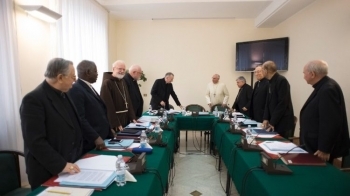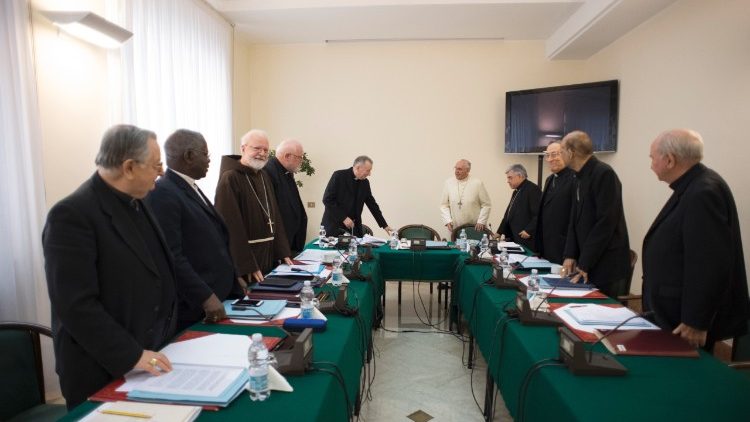
.jpg) Archbishop Felix Machado, Secretary General, CBCI
Archbishop Felix Machado, Secretary General, CBCI

Before stepping aside because of his health, Pope Emeritus Benedict XVI made sure that a Conclave should be held to elect the new bishop of Rome who will be Successor of Peter. The rest is now history. Before the Conclave, the Cardinals from around the world, especially those eligible to vote, gathered in Rome to reflect on “what kind of Supreme Pontiff God wants in the present state of the Church, society and the world”. Among the Cardinals who shared their vision for the “new” Successor of Peter, Cardinal Jorge Bergoglio, Archbishop of Buenos Aires, Argentina, spoke impressively, as it were, hitting the nail on its head, and expressed that God’s will and needs of society, as well as the need of present situation makes the Cardinals look for a right leader to guide the Catholic Church. We also heard that the Cardinals at that pre-conclave meeting had spelt out an outline of the style of papacy the next Pope would adopt, e.g., to work with an advisory committee of a few Cardinals who would help the newly elected Pope to reform the Roman Curia.
Soon after his election, Pope Francis set the ball rolling and the Advisory Committee of the selected Cardinals began meeting. The Apostolic Constitution, Predicate Evangelium (PE), on the Reform of the Roman Curia, was promulgated on 19th March 2022; it will come into effect on 5th June. Many reactions have been circulating on the media. Without going into the details of the PE, I would like to introduce the main and distinct features of PE to the ordinary public.
The news about PE was much awaited. Generally, there seems to be great joy and happiness over the promulgation of PE. The Holy Father has kept his promise and the document continues in the same spirit with which Pope Francis is lauded for his attention, concerns, needs and bold steps. In his nine years of the Pontificate, Pope Francis did not overturn any doctrine but has certainly gone to the heart of renewal and reform of the Church.
Renewal and reform of the Church had been very much on the mind of the Cardinals during the pre-conclave meetings. Obviously, the reform is not an end in itself. Pope Francis has been repeatedly saying that we should implore God in prayer for the gift of authentic ‘discernment’. Paragraph 11 of PE spells out what is meant by ‘reform’. Sometimes I hear a question being asked: ‘Why did the Pope take so many years to do this reform of the Roman Curia?’ Pope Francis had been seriously listening for nine years before he promulgated PE on 19th March 2022.
Published in the midst of Synod on Synodality, the Holy Father states in PE that the face of the Church is synodality. The clear role of the Roman Curia is explained in the context of the synodal Church (LG, 13). Going back to the Second Vatican Council, Pope Francis writes in PE that the Pope and the college of bishops must serve. It is a collegial relationship between Roman Pontiff and the college of bishops. The Roman Curia should help the Pope in strengthening the unity of bishops in the world. The structure of PE clearly presents unity which is desired in the Church.
The Roman Curia is a term for the body of all who are called to assist the Holy Father in his universal service. Since the Pope is known in history as Roman Pontiff, the Successor of Peter who founded the Church in Rome and was martyred in Rome, the body is known as Roman Curia. The word, ‘curia’ comes from the Latin root, ‘curare’ and it signifies “looking after” or “taking care of”; those who take care of the “Servant of the servants of God”, namely the Pope. It must be emphatically made clear that the Roman Curia is not at the personal service of Pope but at his mission entrusted to him by God. The Roman Curia assists the Holy Father in his service to the bishops, for it is co-responsibility in communion. It is made clear that the Roman Curia does not rule the local Churches but is at their service.
The Church is mystery which is inexhaustible. The Church is also an institution; however, that institution is not absolute; institution requires constant renewal and reform. The Roman Curia, therefore, is not just an institution; the pastoral experience of its members makes it integral part of their competence. Over the years the composition of the Roman Curia has gradually and increasingly become an ex
There are about 4,000 members of the Roman Curia, consisting of Cardinals, Archbishops, Bishops, Priests, Religious and Lay men and women. Most of them live outside the precincts of the Vatican City. They all are attached to a number of Offices, now known as, Dicasteries (formerly they were classified in different names according to their categories, such as, Congregations, Councils, Offices, Organisms, Institutions, etc.). The Church who is, first and foremost, the Body of Christ, is also an Institution in order to reach out to all people, Catholics, Christians of other churches and ecclesial communities, people of different religions and those who belong to none. Roman Curia is an important institution for apostolic service. Paragraph 7 of the PE spells out the operative principles of Roman Curia.
It must be noted that the reform of the Roman Curia is a periodically undertaken practice. Its first reform took place in the XVI century. Again, Pope St Pius X did the reform in XX century. The Fathers of the Second Vatican Council explicitly asked Pope St Paul VI for the reform of the Roman Curia which he did with Apostolic Constitution, Regimini Ecclesiae Universae in 1967. The reform of the Roman Curia was again done by Pope St John Paul II in 1988 through his Apostolic Constitution, Pastor Bonus. Pope Francis follows on these last two by bringing more cohesiveness, unity and clarity by fine-tuning details through his Apostolic Constitution, Praedicate Evangelium.
The structure
Divided into 11 chapters and spread in 250 paragraphs, the PE explains, not just the structure, but also the meaning behind the structure. The ‘Preamble’ is the heart of PE. It begins with Jesus’ words in the Gospels of Matthew and Mark: “Go and preach the Gospel…”
This mandate entrusted to the Apostles sets the tone for PE. Pope Francis emphatically says that “this is the first service the Church offers to every human being and to the entire humanity. The principles and criteria of the Roman Curia are clearly spelt out. It is hoped that the “missionary conversion” of the Church is destined to renew the Church after the image and the example of Jesus Christ.
“The Church exists to evangelize”, wrote St Pope Paul VI. Building on that teaching in Evangelii Nuntiandi, Pope Francis in the same spirit, but with his own style makes the reform of the Roman Curia more relevant and practical. I would say that Pope Francis has not made substantial or radical changes. However, the Apostolic Constitution PE becomes a more comprehensive instrument of reform and renewal which Pope Francis has undertaken since the beginning of his papacy and his untiring focus on the reform and renewal of the whole Church.
Pope Francis had worked decisively on some of the changes and they are now holistically presented in PE. For example, Pope St John Paul II, in his Apostolic Constitution, Pastor Bonus, had wished and, therefore, recommended that the Roman Curia works more in solidarity, complementarity and unity. Pope Francis goes to reiterate the same point with more practical way in order to achieve that goal. Pope Francis even gives one name to all Offices in the Roman Curia, namely, “Dicastery”. This leaves no place for anyone to think that one Office is above the other because the ‘dicasteries’ of the Roman Curia are all juridically equal among themselves. PE is a great example of how the Supreme Pontiffs keep on building on the essential teaching of the Church, paying attention to the changes in society and the world. In fact, the Second Vatican Council, according to Pope St John XXIII, had that goal in his famous Italian word, aggiornamento (a spirit of change and open-mindedness).